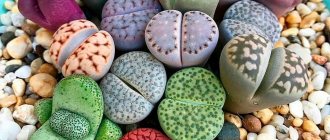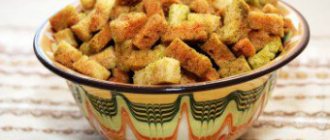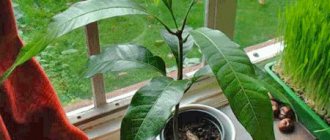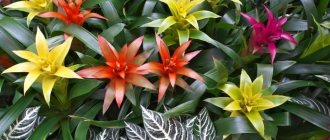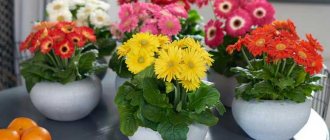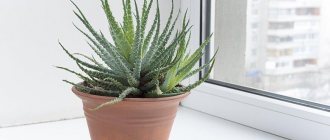- September 22, 2019
- Houseplants
- Maria Vetoshkina
Flower growers love to grow bamboo, because it is easy to care for and you can create a variety of unique compositions from it. At the same time, bamboo is planted differently, and each method has its own advantages. That is why information on how to replant bamboo at home will be of interest to many.
Transfer rules
Bamboo shoots are best germinated in water. They should be transplanted into the ground when the roots reach 4-5 cm. Bamboo cuttings with small roots do not take root well, and roots that are too long are easy to damage during planting. It is necessary to remove the cuttings from the water before planting.
You can use any rooting agent; you just need to sprinkle it on the damp roots. A pot of soil must be prepared in advance; a hole in the soil must be made slightly larger than the rhizome.
The soil should be added in small portions until the pot is filled. The soil should not be compacted too much to avoid damaging the young roots.
After planting, the cuttings are watered and, if necessary, soil is added. In order for the young shoot to take root better, it can be sprayed with water in the first week.
What influences home care?
Indoor bamboo, as it turned out, is unpretentious. However, its favorable existence and care depend on the environment in which it grows. Plant the plant in soil, water and hydrogel.
If you plan to place the dracaena in the ground, then the size of the root system will have a special impact, which will depend on the chosen pot. The smaller the vessel, the shorter the trunk and roots. Owners who want to have a miniature plant must replant it every three years, completely changing the earthen cushion.
In general, the soil requirements for indoor bamboo are not particularly strict. However, it is necessary to ensure airtightness through good drainage. Watering in this case should be moderate.
Since the plant comes from the tropics, you can purchase mixtures for dracaenas, palm trees or ferns at any retail outlet. The substrate must contain the following components: vermicompost, sphangum moss, sapropel and lowland peat. You can determine whether the soil is suitable for you by its color and consistency. It should be dark and quite loose.
If you can’t buy soil in a store, you can experiment. Some prepare the substrate themselves. To do this, you need to take two parts of chernozem or the same amount of a mixture of clay soil and sand. Add one part of middle or lowland peat and one part of humus. If the mixture turns out crumbly and loose, then you can safely plant dracaena in it.
The desire to plant the plant in water is commendable and is welcomed by experts in the field of bamboo cultivation. Dracaena Sander, as it is also called thanks to the florist Frederik Sander, can grow well in a liquid medium. Before planting, wash and inspect all roots for damage. Then you need to place the plant in the selected container, sprinkle the roots with boiled pebbles or other decorative stones and fill with settled water, which should be changed once a week. A prerequisite is to monitor the liquid level. It should cover the bamboo roots at all times.
If the owner decides to grow dracaena in hydrogel, then the planting procedure is similar to the previous option. However, the pot must first be disinfected. First, we inspect the roots and cut off the rotten ones, if any are noticed. Then we move the plant into the selected vessel, pour in the hydrogel and pour in water. The liquid should be added once every few weeks. It must be either settled or distilled water.
Hydrogel has both its advantages and disadvantages. Among the advantages of using such a substance, it should be noted:
- rapid growth of dracaena;
- attractive appearance if the plant is planted in a glass vessel;
- the ability to place hydrogel granules in liquid fertilizer before use, which will have a good effect on the development of bamboo in the future.
Among the disadvantages, experts note the possible appearance of mold and the need to change the substance every two years.
Selecting a site and preparing for transplantation
Before transplanting, you need to prepare everything you need. To do this you will need: a planting container, soil, drainage material, and a means for rooting the flower.
The choice of location also needs to be approached carefully. Bamboo came to us from tropical forests, where the climate is humid and warm. Therefore, a bamboo indoor plant will do well in a warm and well-lit corner. He only needs diffused light; light partial shade is also suitable. The most comfortable temperature is considered to be from 20 to 25 degrees. In the room where bamboo grows, the air should not stagnate.
Temperature
As for the climate, at home, bamboo requires maintaining a temperature in the range from +18 to + 25 °C. A slight increase in this important parameter for the plant is also allowed. An increase in the indicator by 3-5 degrees will not cause any significant changes in the growth and development of dracaena.
It should be noted that for short-sized representatives, a temperature approaching the lower limit is preferable, and for medium-sized representatives, it is better to maintain the upper limit.
Soil and pot for the plant
In what soil should I plant bamboo? This plant belongs to the dracaena family, so for planting it, a ready-made soil mixture specially designed for dracaenas is best suited. It can be purchased at a specialty store.
The container for planting bamboo can be anything, the main thing is that it must meet two requirements:
- The diameter of the pot should be approximately twice the size of the plant's rhizome.
- The pot must have drainage holes.
The plant will look very impressive in a beautiful vase if its stems are additionally tied with a bright ribbon.
Growing space
Bamboo at home requires a certain place. If you follow the recommendations of plant growers, then it should be placed on the windowsill on the eastern part of the house. If you listen to the teachings of Feng Shui, then the location will depend on what goals you want to achieve. The rule of placing decorative bamboo in the east will help you find good luck in your personal life and a strong family. Bamboo on the south side of the house will bring recognition and glory to the owner. You can achieve financial well-being by placing the pot on the south-eastern windowsill.
How to replant bamboo in an apartment
Bamboo is an unpretentious plant; it grows well in water, in soil, and in hydrogel. But he will feel best in the ground.
The process of planting bamboo in a pot is as follows:
- For planting, you need to choose healthy, richly green seedlings that have living, undamaged roots.
- It is better to choose a pot deep enough and spacious enough so that the roots have room to grow. Particular attention should be paid to the drainage holes to ensure the outflow of water from the container.
- The soil, as mentioned above, must be taken ready-made. Expanded clay or small pebbles are suitable for drainage.
- Water for irrigation should be melted or settled.
The drainage layer should be at least 3 cm; moistened soil is placed on it in small portions and a hole is immediately made. The cuttings are taken out of the water, a preparation for root growth should be sprinkled on the roots and a little of this preparation should be added to the hole itself.
The roots are sprinkled with earth, compacted a little, and the pot is completely filled with soil. Water thoroughly so that water flows out through the drainage holes. Water must be removed from the pan so that it does not stagnate.
What does it look like
There are two types of indoor bamboo:
- Medium heights originate from Japanese ancestors. They can reach four meters in length and are grown in private homes with large areas and high ceilings. Such flowers tolerate heat well, but require a lot of light.
- Low-growing representatives are not taller than one and a half meters and can decorate both apartments and office spaces. They can withstand a minimum of light perfectly and will not die in a cool microclimate or in drafts.
The plant has a completely bare trunk, which either grows straight or bends in a spiral. Most often it is characterized by a green color, but there are also golden representatives of the genus. Also, the appearance will depend on the method of planting the indoor plant. Bamboo prefers unobtrusive care, but it will vary slightly in different environments. However, monitoring the presence of moisture in the pot is a prerequisite for a good result. Only the dracaena that receives enough liquid will be beautiful. Let's study what else is important for this plant.
Possible problems
The above describes in detail how to replant bamboo, but after replanting the following problems may arise:
- The tips of the leaves dry out. Dry air or lack of heat is to blame for this.
- The leaves begin to turn yellow. If the leaves turn yellow slowly and infrequently, then this can be considered a natural process. If the leaves turn yellow constantly, this indicates a lack of nutrition; the plant needs to be fed.
- The leaves are curling up. This may be due to low temperature.
- Spots appear on the leaves: yellow-brown or dry. They can be caused by direct sunlight.
Propagation of indoor bamboo
Bamboo propagates
stem cuttings, suckers and apical shoots, sometimes seeds.
Seed propagation in indoor conditions is practically impossible, therefore the only method available to gardeners for propagating indoor bamboo is cuttings
. It is better to cut the plant in the spring, when new, young shoots appear in the spring. Reproduction is carried out during transplantation.
Choose well-fertilized soil for planting cuttings; it is better to buy special soil (for the Dracaena family). Even for small propagated plants, a pot needs to be spacious, since bamboo grows quickly both in the visible field (stems) and in the invisible field (roots).
Indoor bamboo is replanted in the spring once every two years.
. During the growing season from April to August, indoor bamboo needs to be fed every two weeks. For this you can use complex fertilizers for indoor plants, which are sold in flower shops. Loosening the soil has a very beneficial effect on the plant, as it increases the access of air to the roots.
Knowing how to care for a bamboo plant can preserve the green color of the stems and visual appeal for a long time. Dracaena Sandera can symbolize prosperity and success. Feng Shui signs say that it attracts favorable chi energy, charging a person’s home with positive energy.
Lighting, humidity and temperature
Proper lighting is important for any plant. Bamboo, like other dracaenas, loves bright rooms, but direct sunlight will not benefit the plant. Direct sun may cause burns on the leaves. The flower will feel good in diffused sunlight. It will grow in partial shade, but insufficient lighting inhibits growth, and in this case the leaves may turn pale.
Bamboo is a tropical plant, so dry air is unacceptable for it. To humidify the air around the plant, you can place containers of water nearby, or use a special humidifier. The flower will also appreciate daily spraying.
Homemade bamboo loves warmth very much. In an ordinary apartment he will be quite comfortable, you just need to make sure that the air temperature does not drop below 20 degrees. The room where the plant is located can, and even should, be ventilated, but bamboo does not like drafts.
Thus, if you follow the conditions of keeping the plant, then planting bamboo, as described above, will not be difficult, because the plant will be healthy and strong.
What is known about the plant
In fact, how to grow indoor bamboo can be understood by determining its type. It really looks like a miniature copy of the tropical plant of the same name. That is why scientists debated for a long time what species to classify it as. It was recognized either as a bamboo or as an agave, but in the end it was classified as a dracaenaceae, giving the name Dracaena sanderian. In nature, this plant can be found in Africa, Southeast Asia and South America. Translated, the word “dracaena” means “female dragon.” However, according to the teachings of Feng Shui, the plant is considered positive and helps to achieve success in life.
If you come across a spiral-shaped plant, know that this is the result of special cultivation, when the still thin and young stem is placed in a special flask, which is removed after twisting.
Natural conditions allow the bamboo to grow perfectly straight with beautiful little leaves at the top. The average person can try to twist the trunk, guiding it around a decorative post. This manipulation can only be done with young shoots before they become woody. Over time, the stem forms buds that look like constrictions.
Indoors, dracaena can grow up to one meter. Moreover, as soon as it overcomes the threshold of 50 cm, it is recommended to transplant it into a larger pot and move it from the windowsill to the floor.
Plant pests and diseases
A healthy flower is practically not affected by diseases and pests. The latter include spider mites and mealybugs.
The first entangles the leaves with a cobweb. Spraying with Aktara helps combat it.
Mealybug appears as white lumps in the leaf axils. These lumps need to be removed and then treated with the Actellik insecticide.
The following diseases can be noted:
- Dark spots on the leaves are a fungal disease. It is necessary to treat the plant with a fungicide and ventilate the room more often.
- Slow growth - the plant lacks minerals. You need to feed it with a complex product.
- The leaves become dark and soft - the temperature in the room is too low, it needs to be increased.
Why does bamboo turn yellow?
Dracaena is an evergreen plant that periodically sheds its leaves. At first they turn yellow, then fall off, and this is an absolutely normal process. The greatest loss of foliage occurs in spring. However, there are other reasons why bamboo leaves turn yellow:
- low nutrient content in the soil;
- excessive feeding;
- lack of water, light;
- poor drainage;
- low air temperature;
- low humidity;
- drafts;
- presence of harmful chemicals in water.
Major diseases
Homemade bamboo is quite resistant to infections, so it rarely gets sick. The cause of diseases is the introduction of phytopathogens into the home by new plants, soil, tools or gardener's clothing. There are hundreds of possible diseases of Dracaena Sander; they can be fungal, viral or bacterial.
Signs of diseases and drugs for treatment:
- Fungal infections. The appearance of a powdery coating of grayish, brown, dark color on the leaves and stems. Fungicides are used: “Skor”, “Chistoflor”, “Rayok”, etc.
- Viral infections. Variegation, thickening, wrinkling, fragility of leaves. There are no drugs against viruses.
- Bacterial infections. The appearance of wet spots and rot on different parts of the plant. Preparations with bactericidal properties are used: copper sulfate, Bordeaux mixture, Kaptan, etc.
The infected plant is isolated, watering and fertilizing are stopped. The affected leaves are cut off and the wounds are powdered with activated carbon powder. The bush is treated with the selected preparation, following the instructions. Depending on the drug and disease, up to 5 treatments may be needed.
Fact! Once the causative agent of any infection penetrates the vascular system of the dracaena, it is impossible to cure it. There is meaning in treatment only in the initial stages of the disease, when signs of infection are noted only on certain parts of home bamboo.
Caring for a yellowed houseplant
What to do if the bamboo trunk turns yellow? Yellowed leaves or branches must be trimmed with a sharp knife.
You should not leave stems even with small spots, as they will increase in volume. If pruning is not done in a timely manner, yellowness can engulf the plant's trunk, resulting in the death of the flower.
The cut must be left for 3-4 hours until completely dry. Then the cut areas on the bamboo are thoroughly disinfected with finely ground charcoal or purchased charcoal powder. After another 3-4 hours, the remaining unabsorbed coal must be carefully removed.
At the same time, it is important not to touch the sore wounds of the flower. Soft wax is applied over the absorbed charcoal. You can use store-bought wax or use a candle. They light it and wait for the wax to begin to melt.
Important! You cannot drip a candle onto the cut site of the bamboo! Hot wax can severely burn the plant, leading to long-term illness.
Thrips are the most dangerous pest
These are tiny insects. They have an elongated body, reaching no more than 0.4-1.6 mm in length. They can fly. They have two pairs of narrow wings. They multiply quickly . Females are larger in size and have a wider body. They settle on the plant on the trunk, leaves, and twigs.
They look like a dense invasion of small crawling and flying insects. Adults and larvae suck out the cell sap needed by the plant. They get it from plant tissue. The damaged areas die off and small holes form in them.
The leaves begin to wither and fall off. Bamboo is losing its decorative properties. If intervention is not done in a timely manner, pests gnaw out the buds, damaging almost all tissues. If detected, the plant is treated with insecticides . “Fitoverm”, “Vertimek”, “Agravertin”, “Aktelik” are suitable.
Feeding
Dracaena Sander is fed only from May to September. In autumn and winter, the plant's metabolism slows down, and nutrients are required in minimal quantities. Feeding at this time can lead to disruption of the life cycle of home bamboo.
For fertilizing, water-soluble fertilizers with o or “For palm trees” are used. The optimal ratio of nitrogen, potassium and phosphorus (NPK) is 3: 1: 2. It is imperative that the fertilizer contains iron, zinc, manganese, copper, boron and other microelements.
Popular fertilizer brands:
Feeding with nutrient solutions is carried out once a month, combining them with watering. In this case, adhere to the dosage specified by the manufacturer. You can fertilize with each watering, but with a 2-3-fold reduction in the dose of the nutrient complex.
Some gardeners alternate root and foliar feeding. Spraying on the sheet is carried out using a spray bottle, strictly adhering to the optimal concentration of the solution.
Most experts agree that when growing home bamboo in water, fertilizing is not needed. But if there is a lack of nutrients, the plant loses its decorative effect: the color fades, the tips of the leaves turn yellow and darken. In advanced cases, dracaena may die, so it is better to feed it.
When fertilizing homemade bamboo that is grown in water, the dose recommended by the manufacturer is halved. Feeding is carried out once every 2 months. Fertilizer is added to the water during its replacement.
Properly fed dracaena actively develops in spring and summer. This is noticeable by the bright color and growth of leaves and stems. If there is no active development, the fertilizing interval can be shortened. Fertilize once every two weeks until the dracaena responds with stable growth.
The problem can also arise if fertilizers are abused. In this case, the tips of the leaves of Dracaena Sander acquire a brown or yellow color. Fertilizing bamboo should be suspended until it recovers.
Important! Dracaena purchased in a store is not fed for a month. This period of time is needed to acclimatize the plant in a new place. Feeding immediately after moving to a new place creates additional stress on home bamboo. In this case, the plant takes root with difficulty.

